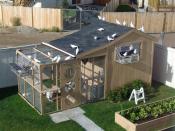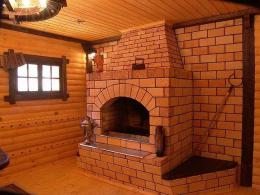Search
Login
Kamenka stove in a Russian bath, step-by-step laying of the stove, how to lay the stove correctly, useful tips
Depending on the owner’s preferences, the bath house can have a different architecture, it can have a different number of rooms, richer, or vice versa, a simple rustic style setting, the only thing a Russian bath can do without is a stove. It is an object of worship, the pride of the owners of the bath. Although the choice of metal heating units is very wide today, lovers of steam often prefer the classic version and build brick stoves. They help to create a special flavor in the bath house, provide it with a sufficient amount of heat and high-quality steam. Of course, the work of erecting a stove-heater for a bath is quite complex and time-consuming, requiring preliminary study and familiarization with the drawings, but armed with patience and the desire to complete it is possible with your own hands.
Content
- The choice of the design of the furnace for the bath video
- Do-it-yourself stove stove - the basic rules of masonry video
- We build the foundation
- Preparing a solution
- How to choose a brick
- The procedure for preparatory work
- Phased construction of a wood-burning stove video
- What is not recommended to save during the construction of the furnace
The choice of the design of the furnace for the bath
As fuel for the sauna stove, high-quality firewood from oak, aspen, and birch is used - they do not spark and do not create soot. Before starting work, you will need to determine what design the furnace will have. It should be noted right away that there can be two options.

Closed stove furnaces They are safer and allow you to steam in the bath at that time. when the firebox works. The heating of stones with this design of the furnace occurs inside the housing, through the wall, which is common to the heater and furnace. Such units are classified as permanent devices. In a closed heater, stones retain heat much longer, while the air in the steam room has a stable optimum temperature. To warm the air in such a bath will take more time, about 4-5 hours.
Second view open-hearth furnaceshaving a periodic principle of operation, suggest the passage of smoke through the stones, before it enters the chimney.
If you want to create the most favorable conditions for vacationers in the steam room, they usually resort to the construction of a furnace with a closed heater.
As a building material, fireclay or refractory bricks are used. The walls of such a stove should have a greater thickness - although this will slow down the heating process, they will retain heat for a long time. Lay the oven in accordance with a special scheme.
The order of the stove-heater shows in detail in what order the bricks of each row are laid, where and how to install the doors, other pieces of equipment, how to construct the channels for the removal of smoke.
Do-it-yourself stove stove - the basic rules of masonry

If you did not have to build an oven before, then it is best not to try to draw up a drawing yourself - you should find a ready-made order and use it. If the estimated weight of the furnace does not exceed 750 kg, then a metal sheet laid on the floor surface can serve as the base of the furnace. If a building with a large weight is expected, then it will be necessary to dismantle the existing floor and build a foundation.
If you follow the rules, then laying the foundation for the stove should be done simultaneously with laying the foundation for the bathhouse. The recommended distance of the heating unit from the walls and from the ceiling should be at least 0.5 m. If combustible materials were used in the construction of the walls, they should be insulated with a metal roofing sheet. Sometimes they resort to the construction of an additional brick wall between the wall and the stove.
For the construction of the furnace, fireclay bricks are used, the chimney and the body can be constructed of refractory. Masonry mortar is used clay, with chamotte additives. If desired, you can purchase a solution for laying the furnace in the form of a dry mixture.
To work, you need such tools and materials:
- bucket and spade,
- construction mixer
- gravel and coarse sand,
- brick battle
- sand and cement for mortar preparation
- fittings,
- waterproofing material.
We build the foundation
Since the weight of the furnace is quite impressive - about a ton, the foundation for it should be sufficiently strong. First, dig a pit with a depth of 0.5 - 0.7 m, depending on the maximum depth of freezing of the soil in the area. It should have a little more depth. The area of \u200b\u200bthe pit should be equal to the area of \u200b\u200bthe base of the furnace.

The bottom is covered with a layer of sand or gravel 0.15 m thick, well packed. Then, a 0.2 m thick brick battle layer is filled up. To fill the foundation, a formwork is constructed from boards, reinforcing fragments are placed in it, and concrete is poured. Sometimes, instead of a wooden structure, a layer of waterproofing is used - roofing felts or a thick plastic film. After the concrete has completely hardened, the boards are removed, the vacant space is covered with coarse sand or gravel.
To equip the waterproofing layer, laying on the foundation of two layers of roofing material or bitumen is used. The construction of a concrete base is not mandatory - you can use buton concrete for this purpose or perform brickwork.
Preparing a solution
Clay for the mortar can be used one that is extracted from a depth of one and a half meters. It is poured into a container, filled with water for a couple of days. To make a high-quality solution from dry clay is much more problematic - it is unlikely to be able to quickly get the desired consistency. The sand is taken river, cleaned. It is sieved through a sieve, mixed with clay in equal proportions.

Water is then added and mixed with a mixer until a homogeneous consistency is obtained. It is very simple to check the quality of the solution, for this you need to dip a piece of wood into it - if it is covered with a uniform, 2 mm thick layer of the mixture, then the solution is ready. If the mixture turns out to be more liquid, then clay should be added to it, if the layer is too thick, more than 3 mm, then sand will need to be added to it.
How to choose a brick

To simplify the process of luggage, you should use a brick measuring 250x120x65 mm. Such proportions will dispense with trimming bricks and increasing the thickness of the joints. The masonry will turn out to be of high quality and will have a neat appearance. Bricks should be chosen without cracks or chips, burnt. It is desirable with the marking M-75 - M-150.
The procedure for preparatory work

When laying brick, one should use schemes-orders; even experienced stove-makers use them when working. The diagrams show in detail each of the brick rows, the location of each brick in a row, the places of fastening of metal fittings, each structural element are marked. If there are roundings or bulges in the walls of the furnace, they are cut with a grinder.

Before starting work, it will be necessary to prepare the tools and auxiliary equipment that will be needed when performing the masonry:
- container for solution
- bucket for soaking bricks,
- hammer, level, square,
- trowel,
- emery wheel or grinder,
- pliers - with their help it will be more convenient to carry out wire fasteners,
- construction mixer.
Further work will consist of laying bricks on clay mortar. Brickwork is staggered into brick. If the mortar is of good enough quality, then the masonry should be performed with a seam width of about 3-5 mm. Spoon dressing is also recommended.
Phased construction of a wood-burning stove

First, even before laying the first row, a pad is executed - i.e. a layer of brick covering the entire surface of the base of the furnace. Its perimeter should correspond to subsequent rows, the angles should be perfectly straight, the diagonal skew should not exceed 3 mm. The solution is not used when laying this row. Before laying bricks, they should be well moistened in water.
Masonry of the following rows is performed on clay mortar. To make sure that the brick is laid correctly, each row should be checked with a level, each of the corners with a square.

An obligatory element of the design of the furnace is an ash pan. It serves to collect ash and provide good traction in the furnace. It is better if it is cast from cast iron, which is refractory metal. A door is installed in the third row. Quality components for the furnace should be purchased in advance. As fastening material for sashes, tin strips or wire are used, their installation is carried out in the wall. Trimming the brick above the door is performed at an angle - to increase the strength of the structure, because the metal elements inside the bath are subjected to strong heating.

On the fourth row, they begin to equip a well for ash and grate. The door should be installed on the 6th row of masonry, grates - on the seventh. Installation of grates is carried out in such a way that, with a significant increase in temperature, the material can expand unhindered. To create a sufficient gap in the brick, a recess is made of a depth of about 2 cm, a grill is placed in it.
Rows from the eighth to fourteenth masonry are performed with a partition. In the 14th row finishing this part of the furnace, channels and a boiler are installed for heating water, in the event that a stove with a tank is being constructed. The stoves that are simpler in design are not equipped with containers for heating water.
The laying of bricks in rows 15-18 is done on the rib, and in the 19th row a door is installed for steam to enter the steam room.

The next two rows are reinforced with wire, then the pipe is installed. It is desirable that its height exceed the height of the roof ridge by 1.5 m. The pipe is laid on a regular cement mortar - it will be exposed to temperatures and various atmospheric phenomena.

After the oven walls have dried, you can proceed to its external decoration. If the masonry with fireclay bricks is done carefully, then you can refuse. If desired, the stove can be plastered and bricked.
If the chamotte brick masonry is made efficiently, the stove will quickly warm up the room and keep it warm for a long time, the stove is also covered with chamotte brick.
The sauna heater is calculated taking into account the fact that for heating 1 cubic meter of a steam room you need about 30 kg of stone. A closed type heater should be equipped with two windows with a side size of about 35 cm. The optimal location of the stove - near the door - in this case it will be easier to put firewood in the firebox, which opens into another room.
What is not recommended to save during the construction of the furnace

Considering the construction of a brick stove Kamenka, it should be noted that its only drawback is its considerable cost. You can slightly reduce costs by doing the laying yourself. If you follow the instructions and the order exactly, it is quite possible to get an excellent result. At the same time, you can not save on building materials - the use of cheap analogues in any case will lead to a deterioration in the quality of the furnace.





